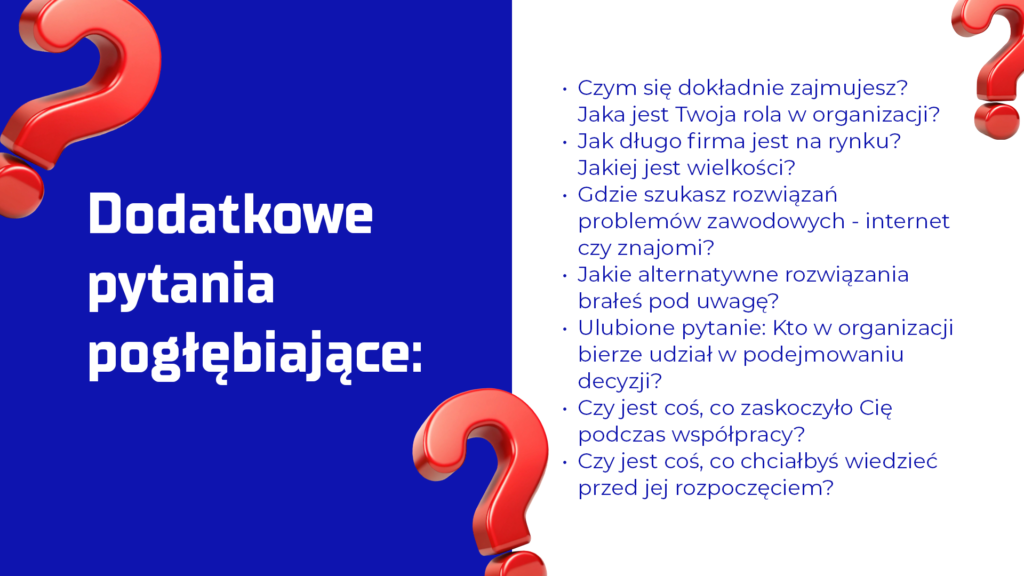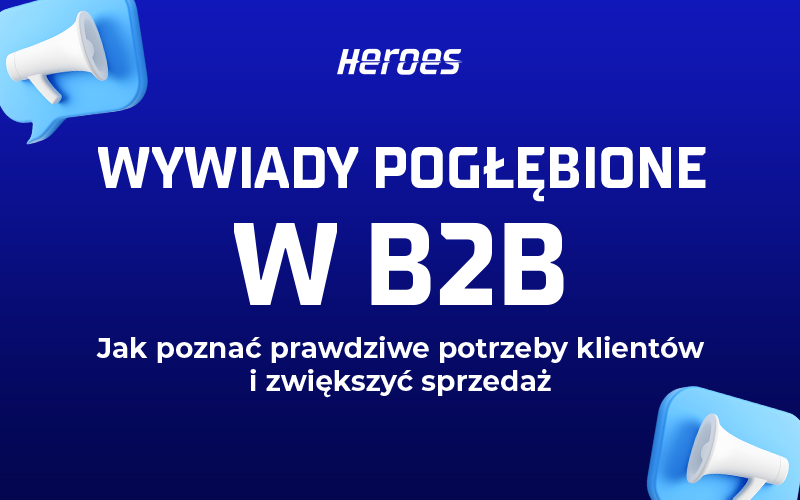Think you know your customers? 9 out of 10 B2B companies do not have properly defined buyer personas. In-depth interviews combined with AI can completely transform your approach to marketing and sales - here's a proven step-by-step process.
Most B2B companies base their marketing strategy on guesswork. They think they know who their customers are, what they need and what motivates them to buy. The result? Wasted advertising budgets, ineffective campaigns and disappointing sales results.
In-depth interviews are a method that provides insight into the client's reality, not just our perception of it. These are structured conversations that allow you to understand your customers' perspective, needs and expectations at a much deeper level.
Why most companies don't know their customers
From the experience of the Heroes agency, which has conducted more than 750 sales calls, the conclusion is clear: 9 out of 10 customers we ask about buyer persona do not have them correctly defined. And without that, we're shooting in the dark.
Typical mistakes in understanding customers:
- Focus on product features instead of customer benefits
- Assumptions based on your own perspective - What seems logical to us is not necessarily relevant to the buyer
- Lack of knowledge of the decision-making process - we don't know who is really deciding on the purchase
- Unfamiliarity with the customer's language - we use industry jargon instead of the words the customer uses to describe their problems
Specific benefits of in-depth interviews
Conducting systematic in-depth interviews yields measureable results:
1. real data instead of conjecture
You stop guessing what the customer is thinking and start just knowing it.
2 Customer language insights
You learn what words they use to describe their problems - invaluable in marketing communications.
3. understanding the decision-making process
You learn what the customer's journey from problem to purchase really looked like.
4. identify true concerns and motivations
Often, clients decide to cooperate for reasons we hadn't even thought of.
5. inspiration for new products and services
Customers are a real well of ideas - they often suggest what they are missing themselves.
Important: Companies that regularly talk to their customers and tailor communications to them achieve much better sales results. Instead of shooting blindly, they hit the exact needs of their audience.
Step by step: how to conduct in-depth interviews
1. customer segmentation
Before you start calling everyone in your base, segment your customers into groups with similar characteristics. In B2B, we typically use three main segments:
- Long-established business owners
- Directors
- Decision makers from specific departments
Attention: Don't create too many segments. If the owner of a one-person business buys a product in exactly the same way as a sales director in a corporation, there is no point in dividing them into separate groups.
2 Create a hypothesis
Before the interviews, write down what you think about your customers:
- Who are they?
- What problems do they have?
- What motivates them?
This will be a hypothesis that you will verify later. At first, these are just assumptions - you'll find out the truth in interviews.
3. prepare the right questions
Key principle: Avoid closed questions that can be answered with a "yes" or "no." Each question should open the conversation, not close it.
Questions tested on hundreds of interviews:
Question #1: "What is the biggest challenge at this point in your daily work? What do you face?"
- Why it works: It identifies the customer's real problems, not the ones we think they have
Question #2: "What were your concerns before you started working with us?"
- Why it works: Uncovers the real barriers to purchase that you can then solve in communication
Question #3: "What was the key factor that determined our cooperation?"

Practical conduct of interviews
Don't be afraid to call
One of the biggest barriers is fear of contact. The reality is different: when the customer feels that you are really interested in his opinion, he will want to talk longer than you planned.
A proven script to start with: "Good morning, this is [name] from [company]. We had the opportunity to collaborate on [project name]. I'd like to have a short conversation about our collaboration, which will take about 15 minutes, and the answers will help us do what we do even better. Is this a good time?"
Key principles for conducting interviews
- One presenter - too many people may intimidate the caller or disrupt the flow of information
- Adapt to customer preferences - If he prefers a phone call on the way home, don't force a formal online meeting
- A minimum of 10 interviews - usually after 10 calls you start to anticipate responses, which signals enough data
- Be flexible - dig deeper into topics that seem particularly relevant
AI revolution in intelligence analysis
Traditionally, interview analysis is a tedious, time-consuming process. Artificial intelligence allows it to speed it up considerably and draw more valuable conclusions.
A proven workflow with AI:
- Automatic transcription - use tools like Fireflies, Loom or built-in features in videoconferencing platforms
- Collecting transcripts - all calls in one place
- AI analysis - you load transcripts from a dozen interviews into ChatGPT, Claude or another tool
- Finished analysis - you get customer benchmarks and motivations
AI not only saves hours of work, but also notices patterns that the human eye might not catch - especially when analyzing more than a dozen interviews simultaneously.
Sample analysis prompt:
Analyze the following transcripts of interviews with my clients, identifying:
- Recurring problems and challenges
- Main purchase motivations
- Most common concerns before purchase
- Key words and phrases to describe the needs
- Common demographic and psychographic characteristics
- Patterns in the decision-making process
[here you paste all transcripts].
Case studies: how interviews change business
The case of #1: Textile company - discovery of a key factor
Situation: We interviewed the textile company's B2B distributors.
Discovery: Distributors pointed to the delayed 90-day payment, which the company had offered but dropped.
The result: It turned out that the ability to order product and liquidate it before incurring costs was crucial. After implementing the new payment formula, of the 15 distributors we interviewed, as many as 10 immediately placed new orders.
Case #2: UX/UI company - misidentification of decision makers
Situation: We thought that the decision-makers were technical specialists.
Discovery: The initiators of the purchase were project managers who noticed an overload of resources.
The result: We organized webinars on project management in IT, which allowed us to reach the right target audience and significantly increase the number of leads.
These cases show how sometimes small discoveries from interviews can lead to spectacular business results.
Transformation of buyer personas based on interviews
After collecting interviews, it's time to update the buyer personas. Focus on the elements that have been repeated most often:
Before the interviews (hypothesis):
- Customer X: Marketing director, looking for technical solutions
- Problem: Lack of time for campaigns
- Motivation: He wants to increase ROI
After the interviews (reality):
- Client X: Project manager with a technical background
- Problem: Team overload and lack of resources
- Motivation: He wants to ease the burden on the team to focus on strategic projects
- Language: He uses the words "team efficiency," "process optimization"
- Concerns: Won't the new solution complicate current processes
- Decision making: Decision after consultation with technical team
Putting conclusions into practice
1. marketing communications
Use exactly the same words and phrases, which clients used in interviews. This is the language they use to describe their problems.
2. advertising campaigns
Address specific concerns identified in interviews in advertising texts and landing pages.
3. sales process
Customize your sales arguments to the real motivations and concerns of customers.
4. product development
Focus on functionsthat customers really value, not on the ones that seem most important to you.
FAQ - the most common questions about in-depth interviews
Q: Will customers want to talk to me? A: Yes! When the customer feels that you are really interested in their opinion, they will want to talk longer than you planned. You will be the one who has to cut off the conversation.
Q: How many interviews should I conduct? A: A minimum of 10 interviews per segment. Usually after 10 interviews you start to anticipate responses.
Q: How long should an interview last? A: Plan for 15-20 minutes, but be prepared for longer interviews. A qualitative interview can take as long as 30-40 minutes.
Q: What if I don't have customers yet? A: Talk to potential clients who have not made up their minds. Ask about their concerns and the alternatives they are considering.
Q: Can AI replace human intelligence analysis? A: AI supports analysis wonderfully, picking up patterns, but human interpretation of context and nuance is still key.
Summary: From conjecture to data
In-depth interviews are the difference between shooting blind and hitting it right. Companies that invest time in getting to know their customers achieve much better results - both in marketing and sales.
Key findings:
- 9 out of 10 B2B companies don't truly know their customers
- The right questions open up real needs and concerns
- AI can speed up analysis and catch patterns invisible to the naked eye
- Small discoveries from interviews can bring spectacular business results
Ready for action?
At Heroes, we believe that Setting up advertising is only 25% of success. Real results come from combining marketing with an understanding of the sales process. Our experience with more than 100 campaigns and 750 sales calls shows: small changes in the approach to the customer yield big results.
Schedule a free strategy call and learn how in-depth interviews can transform your sales results.

